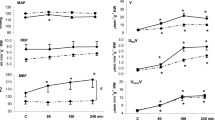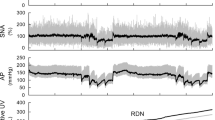Abstract
It is well established that renin release from the juxtaglomerular epithelioid cells in the media of the afferent arteriole strongly depends on the mean renal perfusion pressure, whereas a possible influence of the pulsation of blood pressure on renin release has only occasionally been investigated, and the results are contradictory. Such an influence on renin release cannot be excluded because pulsation is known to modulate arterial baroreceptors and vascular tone in some resistance vessels. In the isolated perfused rat kidney, we found a pulsation amplitude-dependent inhibition of renin release that could be blocked either by vasodilatation or by calcium channel blockade. The inhibition occurred at perfusion pressures between 85 and 125 mm Hg. The underlying pulsation pressure-sensitive mechanism has to be ascribed integrating properties, because a constantflow pressure rise to the “systolic” value of pulsatile perfusion resulted in virtually the same inhibition of renin release. Moreover, a reduced urine flow during pulsatile perfusion provides evidence for preglomerular constriction under these conditions. It is concluded that, besides pathological changes of renal perfusion pressure, variations of the pulse amplitudes, e.g. resulting from renal artery stenosis or atherosclerosis, may also influence renin release and contribute to renovascular hypertension.
Similar content being viewed by others
References
Aukland K, Oien AH (1987) Renal autoregulation: models combining tubuloglomerular feedback and myogenic response. Am J Physiol 252: F768-F783
Blendstrup K, Leyssac PP, Poulsen K, Skinner SL (1975) Characteristics of renin release from isolated superfused glomeruli in vitro. J Physiol 246: 653–672
Cantin M, Araujo-Nascimiento M de F, Benchimol S, Desormeaux Y (1977) Metaplasia of smooth muscle cells into juxtaglomerular cells in juxtaglomerular apparatus, arteries, and arterioles of the ischemic (endocrine) kidney. Am J Pathol 87: 581–602
Churchill PC, Churchill MC (1982) Ca-dependence of the inhibitory effect of K-depolarization on renin secretion from rat kidney slices. Arch Int Pharmacodyn Ther 258: 300–312
Ehmke H, Persson P, Kirchheim H (1987) A physiological role for pressure-dependent renin release in long-term blood pressure control. Pflügers Arch 410: 450–456
Farhi ER, Cant JR, Barger AC (1982) Interaction between intrarenal epinephrine receptors and the renal baroreceptor in the control of PRA in conscious dogs. Circ Res 50: 477–485
Fray JCS (1976) Stretch receptor model for renin release with evidence from perfused rat kidney. Am J Physiol 231: 936–944
Fray JCS (1980) Mechanism by which renin secretion from perfused rat kidneys is stimulated by isoprenaline and inhibited by high perfusion pressure. J Physiol 308: 1–13
Fray JCS, Lush DJ, Park CS (1986) Interrelationship of blood flow, juxtaglomerular cells, and hypertension: role of physical equilibrium and Ca. Am J Physiol 251: R643–62
Fray JCS, Park CS, Valentine AND (1987) Calcium and the control of renin secretion. Endocr Rev 8: 53–93
Hackenthal E, Taugner R (1986) Hormonal signals and intracellular messengers for renin secretion. Mol Cell Endocrinol 47: 1–12
Hackenthal E, Aktories K, Jakobs KH, Lang RE (1987) Neuropeptide Y inhibits renin release by a pertussis toxin-sensitive mechanism. Am J Physiol 252: F543-F550
Hawthorne DW, Perry SL, Pogue WG (1953) Development of experimental renal hypertension in the dog following reduction of renal artery pulse pressure without reducing mean pressure. Am J Physiol 174: 393–396
Kirchheim HR, Ehmke H, Hackenthal E, Lowe W, Persson P (1987) Autoregulation of renal blood flow, glomerular filtration rate and renin release in conscious dogs. Pflügers Arch 410: 441–449
LaLone BJ (1975) Local regulation of sceletal muscle blood vessels: influence of pulse pressure and vasomotor tone. Ph. D. thesis, East Lansing, Michigan State University. Cited in: Johnson PC (1983) Handbook of physiology. American Physiological Society, Bethesda, Md.
Lansman JB, Hallam TJ, Rink TJ (1987) Single stretch-activated ion channels in vascular endothelial cell as mechanotransducers. Nature 325: 811–813
Many M, Giron F, Birtwell WC, Deterling RA, Soroff HS (1969) Effects of depulsation of renal blood flow upon renal function and renin secretion. Surgery 66: 242–249
Ritter ER (1952) Pressure flow relations in the kidney — alleged effects of pulse pressure. Am J Physiol 168: 480–489
Sagawa K (1983) Baroreflex control of systemic arterial pressure and vascular bed. In: Shepherd JT, Abboud FM (eds) Handbook of physiology, section 2. The cardiovascular system, vol III. American Physiological Society, Bethesda, Md.
Schwertschlag U, Hackenthal E, Hackenthal R, Rohs HG (1978) The effects of calcium and calcium-ionophores (X 537 and A 23187) on renin release in the isolated perfused rat kidney. Clin Sci Mol Med 55: 1635–1665
Shoor PM, Marzec UM, Griffith LD, Hammill FS, Dilley RB, Bernstein EF (1979) Renin secretion in the chronically perfused pulseless calf. Evidence for failure of stimulation by decreased pulse pressure. Circ Res 45: 100–107
Sigurdsson StB, Johansson B, Mellander St (1977) Rate-dependent myogenic response of vascular smooth muscle during imposed changes in length and force. Acta Physiol Scand 99: 183–189
Skinner SL, McCubbin TW, Page LH (1964) Control of renin secretion. Circ Res 15: 64–76
Taugner R, Nobiling R, Metz R, Taugner F, Bührle C, Hackenthal E (1988) Hypothetical interpretation of the calcium paradox in renin secretion. Cell Tissue Res 252: 687–690
Tobian L (1962) Relationship of juxtaglomerular apparatus to renin and angiotensin. Circulation 25: 189–192
Author information
Authors and Affiliations
Rights and permissions
About this article
Cite this article
Nobiling, R., Münter, K., Bührle, C.P. et al. Influence of pulsatile perfusion upon renin release from the isolated perfused rat kidney. Pflugers Arch. 415, 713–717 (1990). https://doi.org/10.1007/BF02584010
Received:
Revised:
Accepted:
Issue Date:
DOI: https://doi.org/10.1007/BF02584010




